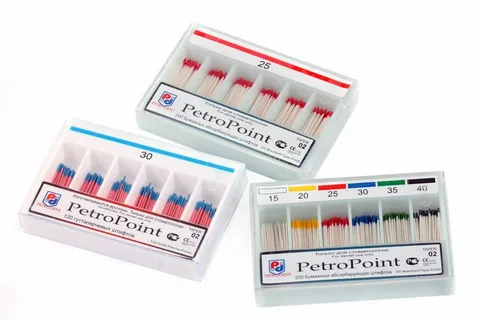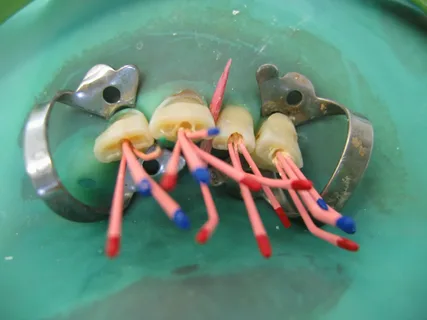Evolution of the Use of Gutta-Percha as a Filler
Machine translation
Original article is written in RU language (link to read it) .
Root canal filling is a key stage of endodontic treatment. To achieve the highest quality result, it is important to remember the tasks that the doctor must solve at this stage.
About the evolution of obturation methods in the webinar Black and White Aesthetics in Endodontics. Obturation Problems.
The following tasks of the root canal system filling stage are highlighted:
- elimination of communication between the tooth cavity and the root canals;
- isolate the bacterial flora that remains in the accessory, and sometimes in the main root canal;
- prevent the penetration of tissue fluid into the canal lumen from the periapical tissues.
For reliable root canal obturation, a filler and sealer are used. Today, most dentists prefer gutta-percha, predominantly using it as a filler.

Figure 1. Gutta-percha pins.
This is due to the fact that gutta-percha has a number of undeniable advantages:
- inertness;
- spatial stability;
- does not provoke allergic reactions;
- no staining of dentin;
- easily compacted;
- radiopacity;
- softens when heated;
- becomes soft under the influence of organic solvents;
- can be easily removed from root canals if necessary.
There are two types of gutta-percha:
- β-gutta-percha is characterized by a higher melting point, high flexibility, low stickiness;
- α-gutta-percha is different in that it has a lower melting point, is ductile, and has high stickiness.

Figure 2. Gutta-percha on a carrier.
The functions essential for a quality sealer include:
- filling of dentinal tubules, voids, microspaces;
- leveling any irregularities of the canal wall;
- providing sliding of gutta-percha pins.
During the root canal filling stage, the sealer is the weak link, it is important to ensure that its amount around the filler is minimal.
All the variety of sealers can be divided into the following groups:
- based on organic resins;
- based on MTA;
- silicone;
- glass ionomer cements;
- zinc oxide-eugenol;
- based on calcium hydroxide;
- based on dentin adhesives.
Today, the most popular are sealers that are produced based on organic resins.
Advantages of the representatives of this group of sealers:
- biocompatibility,
- high sealing performance,
- optimal working time,
- low viscosity.
However, there are also some disadvantages of organic sealers:
- sensitive to moisture,
- sensitive to even minimal content of oxidizers in the canal (hydrogen peroxide),
- if extruded beyond the apex, they cause severe post-obturation pain, hence accurate working length verification is important.
Obturation Methods
Classification of root canal obturation methods:
When using cold gutta-percha:
- chemical plasticization (using eucalyptol);
- lateral condensation.
When using heated gutta-percha:
- thermomechanical condensation (by using ultrasound or a gutta-condenser);
- vertical condensation.
When using thermoplasticized gutta-percha:
- core carrier insertion (Thermafil, GuttaCore);
- filler injection method (Ultrafil).

Figure 3. Materials for endodontics.
Lateral Condensation
Today, lateral condensation remains the most demanded filling technique, consisting of the following steps:
- The root canal, after completing mechanical and medicinal processing, must be thoroughly dried with paper points, then proceed to fitting the main gutta-percha cone, which should match the size of the main file and, without encountering any obstacles, is inserted to the working length into the canal. If the cone cannot be inserted to the working length, the mechanical processing step is repeated.
- The sealer is introduced into the root canal using a master file or a canal filler.
- The main cone is placed in the canal and lateral (side) compaction is performed using a spreader. To prevent the cone from being pulled out when removing the instrument, extraction is performed with rotational movements.
- Introduction of an additional cone, which is pre-dipped in sealer. Its condensation is performed similarly to the main cone. Compaction with additional cones continues until the spreader penetrates the canal by more than a few millimeters.
- Excess gutta-percha is removed with a heated instrument at the level of the canal orifices, followed by vertical compaction using a plugger or a small condenser.
- Control radiograph.
Vertical Condensation
It is believed that this technique allows for more reliable isolation of all channel branches.

Figure 4. Sealing of tooth root canals.
The essence of the technique is presented by the following protocol:
- The main gutta-percha pin is fitted into the root canal, previously its length is reduced by 2 mm from the working length. Then, pluggers are fitted in such a way that the first one passes through the crown part, the next one through the middle, and the last one stops 2 mm short of the working length.
- The pin is placed in the canal, heated, compacted with a plugger in a vertical direction, and the excess gutta-percha is removed.
- Standard preforms are introduced into the canal, which are 2-3 mm in length, they are also heated and compacted. The filling is carried out up to the very orifice.
- The technique provides obturation of lateral canaliculi, apical delta, but technically it is quite complex. To simplify the process, a technique of introducing pre-heated gutta-percha into the canal was developed.
Injection Techniques
Sequence of gutta-percha injection:
- Drying the canal, heating the gutta-percha in a special device to a temperature of about 200 degrees. While the gutta-percha is heating, the needle is adjusted so that it is positioned at the boundary between the middle and apical thirds of the canal. The plugger should freely enter up to the apical part, stopping 2 mm before the end of the working length.
- The canal walls are lubricated with sealer.
- The heated gutta-percha is inserted through the needle without pressure towards the apex, filling the apical third of the canal.
- Gradually withdrawing the needle, the root canal is filled up to the orifice.
- Using the plugger, the gutta-percha is compacted apically. Additional gutta-percha is added if necessary.
The injection methods include the Ultrafil technique, which has a number of features:
- gutta-percha blanks with different degrees of viscosity are used,
- gutta-percha fills the canal through a special syringe, which automatically measures the amount with each press.
Injection methods guarantee dense obturation of the root canal system with all its branches, but there remains a high risk of material penetration beyond the apex and burns to the surrounding tissues.
Thermoplasticized Gutta-percha
The Thermafil system provides for the introduction of heated gutta-percha placed on a rigid carrier (plastic or metal), which easily bends and allows the softened gutta-percha to be pressed into all branches of the canal.
The sequence of steps is as follows:
- A verifier is fitted into the root canal — this is a metal blank that replicates the carrier with gutta-percha in its configuration. It should freely enter the canal to its full length.
- The canal walls are coated with sealer.
- The carrier covered with gutta-percha is placed in a special oven and heated to a certain temperature.
- The pin is inserted into the canal to the working length.
- The pin is cut off 1 mm from the orifice with a bur, while it is important to maintain pressure towards the apex to prevent the pin from shifting.

Figure 5. Endodontic treatment.
The GuttaCore system provides for the introduction of heated gutta-percha on cross-linked gutta-percha obturators. The technique involves the following steps:
- The verifier is adjusted in the root canal.
- The canal walls are lubricated with sealer. Excess sealer is removed with a paper point.
- The gutta-percha coated pin is placed in the Thermaprep oven and heated to a specific temperature.
- The pin is inserted into the canal to the working length, avoiding contact with the walls.
- The handle of the obturator and the rod are removed.
Thermomechanical Condensation of Gutta-Percha
Steps
- Preparation and subsequent insertion of the main pin, lubricated with sealer.
- Insertion of the rotating condenser into the canal until resistance is felt, then it is carefully removed while rotation continues.
- In the vertical direction, gutta-percha is compacted with a plugger.
For more current information, visit the online course What’s NEW in Endodontics: From Anesthesia to Obturation.

